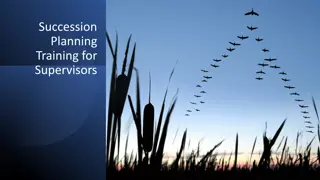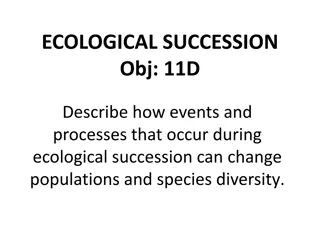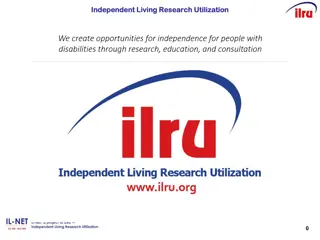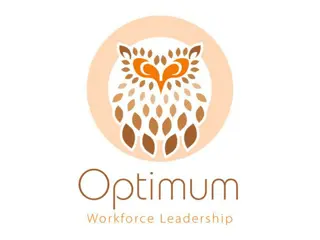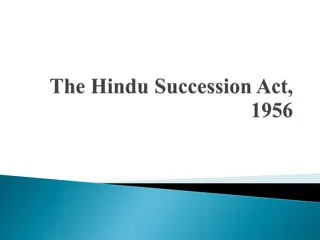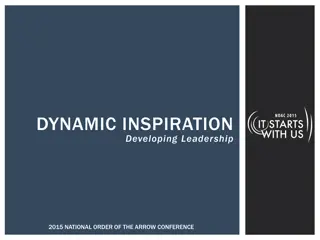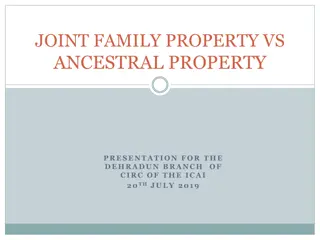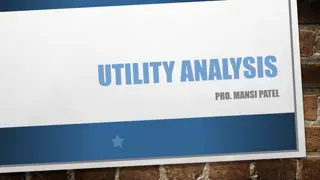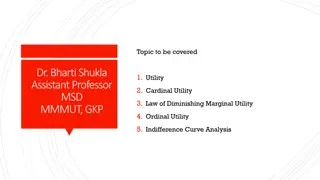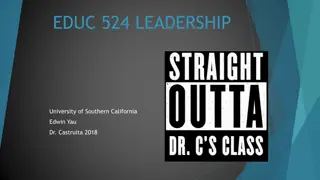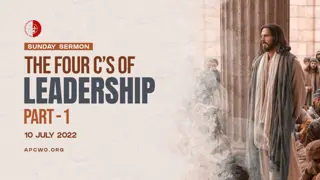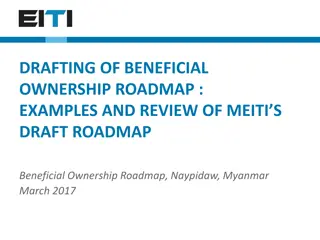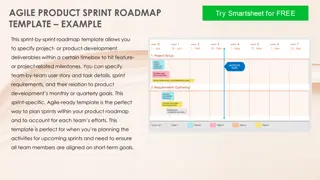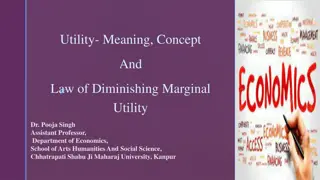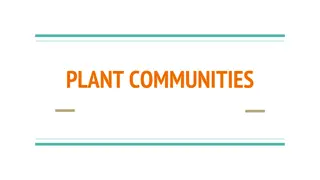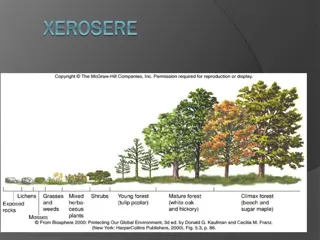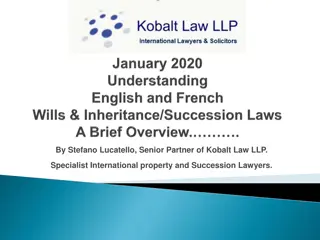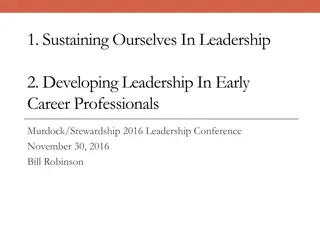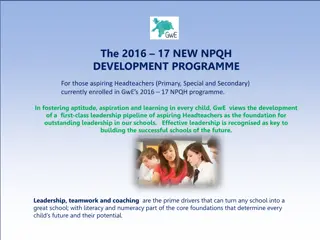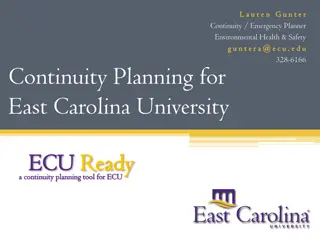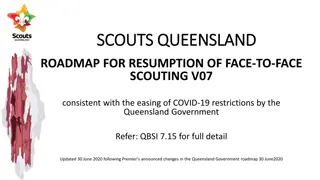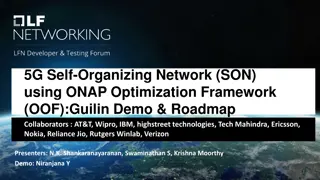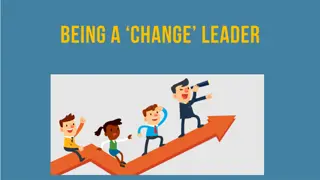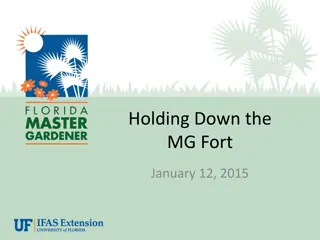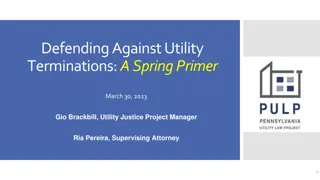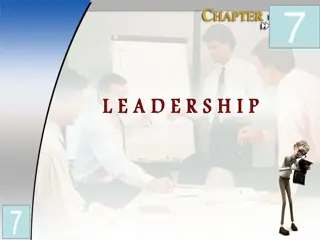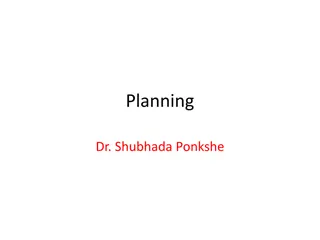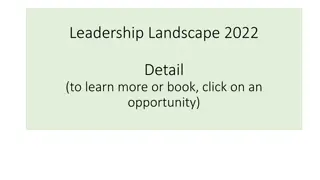Developing a Roadmap for Leadership and Succession Planning in Utility Management Conference
This presentation highlights the importance of succession planning in the utility management sector, focusing on identifying components of a successful plan, exercises for self-assessment, and strategies for ensuring knowledge transfer. With a crisis looming due to an aging workforce, the need for effective leadership development and succession planning is paramount for organizational continuity.
Download Presentation

Please find below an Image/Link to download the presentation.
The content on the website is provided AS IS for your information and personal use only. It may not be sold, licensed, or shared on other websites without obtaining consent from the author. Download presentation by click this link. If you encounter any issues during the download, it is possible that the publisher has removed the file from their server.
E N D
Presentation Transcript
Developing a Roadmap for Developing a Roadmap for Leadership and Succession Leadership and Succession Planning Planning Utility Management Conference Tampa, FL February 7, 2017
Components of a Successful Succession Plan Jonathan P. Ruff, P.E. Environmental Manager City of Plattsburgh, NY ruffj@cityofplattsburgh-ny.gov 518-536-7519
Goals Goals Identify components of a succession plan Provide exercises for rating your organization for each component Serve as the basis for the rest of the workshop
Houston, weve got a problem. Houston, we ve got a problem.
Crisis Background 78 million baby Boomers turning 65 in 20 years 16% of workforce is over 55. 25% over 55 by 2020. Retiring en-masse. Insufficient replacements available.
Employees Leave Employees Leave They always do They always do Preparation for that day is Succession Planning
Succession Plan Succession Plan A systematic approach to building replacement workers to ensure continuity, by identifying potential successors in critical work processes.
Also Includes Knowledge Transfer Also Includes Knowledge Transfer Processes and strategies that allow an organization to: Document key data and policies for critical work processes Exchange key process data and information from one individual or group to another Define how vital and important information will be retained within the organization despite attrition
Context Context Employer Ensure a sufficient supply of talent for key roles and tasks. Employee Provide clear opportunity to grow, learn, evolve, advance. Customer Results. Employees and service that are reliable, knowledgeable, and meet their expectations.
Employee and Leadership Development Employee and Leadership Development Recruits and retains a workforce that is competent, motivated, adaptive, and safe- working. Establishes a participatory, collaborative organization dedicated to continual learning and improvement. Ensures employee institutional knowledge is retained and improved upon over time. Provides a focus on and emphasizes opportunities for professional and leadership development and strives to create an integrated and well-coordinated senior leadership team.
Employee and Leadership Development Employee and Leadership Development 1. Employee retention and satisfaction 2. Management of core competencies 3. Workforce succession preparedness
Basic Components Basic Components 1. Institutionalize the process and capture stakeholder support Conduct assessments of organizational needs Develop the succession planning model Implement succession planning strategies Continuously measure, evaluate, and adapt 2. 3. 4. 5.
Rate Your Organization Rate Your Organization Consider questions about your organization. Rate where you are on scale of 1 5. 1 Never 2 Not Often 3 Sometimes 4 More Often than Not 5- Always
Basic Steps Basic Steps AWWA/WEF Utility Management Conference 2017 Workshop Developing a Roadmap for Leadership and Succession Planning Basic Steps 0. Succession Plan 1. Institutionalize the process and capture stakeholder support 2. Conduct Assessment 3. Develop the succession planning model 4. Implement succession planning strategies 5. Continuously measure, evaluate, and adapt More Often Always (5) Than Not (4) Sometimes (3) Not Often (2) Never (1) Total Step 0 - Succession Plan We use a Succession Plan that is up to date and one of our most important staffing tools. Our Succession Plan is an integral part of our organization's comprehensive strategic plan. Sum: Sum/2
Step 1 Step 1 Institutionalize Process and Develop Stakeholder Support Institutionalize Process and Develop Stakeholder Support AWWA/WEF Utility Management Conference 2017 Workshop Developing a Roadmap for Leadership and Succession Planning More Often Always (5) Than Not (4) Sometimes (3) Not Often (2) Never (1) Total Step 1 - We have institutionalized the process and capture stakeholder support for the plan a. We gain commitment from decision makers We demonstrate why it s needed and benefits b. We gather resources for developing and implementing the plan Senior leadership HR/Civil Service Union representative Employees groups Others c. We understand the role of succession planning in achieving the strategic vision and goals of our organization We make succession planning a priority Our strategic plan determines the # of future employees and skills needed Strategic Plan Defining the organization s direction and allocating resources to get there. Here is where we need to be and here is how we re going to get there. We understand what a succession program looks like and what will it do for our organization Sum: We incorporate succession planning into our organization s values We clearly define the objectives for the program Sum/3: Page 2 - Components of a Successful Succession Plan
Step 2a Step 2a Conduct As Is Assessment Conduct As Is Assessment AWWA/WEF Utility Management Conference 2017 Workshop: Developing a Roadmap for Leadership and Succession Planning More Often Step 2a - Conduct an Assessment Always (5) Than Not (4) Sometimes (3) Not Often (2) Never (1) Total a. Conduct As Is Assessment of Organization We collect and analyze organization and demographic data Retirements? New leaders being developed? Are you identifying new leaders? What is average age and tenure of current employees? What are attrition and vacancy rates? We identity and prioritize key work processes/positions Which are most critical? Which have the least amount of resource depth? Which processes are documented? Are future replacements and leaders prepared? We identify condition and availability of resources and systems What items are needed to do work? Maps, policies/procedures, training guides? Are they accessible and up to date? What technology systems are currently in use? 2a Sum: 2a Sum/3: Page 3 - Components of a Successful Succession Plan
Step 2b Step 2b Conduct To Be Assessment Conduct To Be Assessment AWWA/WEF Utility Management Conference 2017 Workshop Developing a Roadmap for Leadership and Succession Planning More Often Step 2b - Conduct an Assessment Always (5) Than Not (4) Sometimes (3) Not Often (2) Never (1) Total b. Conduct To Be Assessment of Organization We analyze future requirements for services Future demand Customer expectations Regulations What are the goals of the Strategic Plan Demand placed by Succession Plan How will Succession Plan change workforce/leadership requirements? We are aware of upcoming changes in the industry. We are aware of what demands technology will place on organization. 2b Sum: 2b Sum/4:
Step 2c Step 2c Conduct Gap Analysis Assessment Conduct Gap Analysis Assessment AWWA/WEF Utility Management Conference 2017 Workshop Developing a Roadmap for Leadership and Succession Planning More Often Step 2c - Conduct an Assessment Always (5) Than Not (4) Sometimes (3) Not Often (2) Never (1) Total c. Conduct Gap Analysis How does as is organization fall short of to be ? Our workforce is prepared for the future Do current organizational demographics look like the future ones? Are you prepared to handle shifts in demographics? Do we have the people skills to keep up with the change? We are prepared to adapt to future processes Which ones are most susceptible to changes in personnel? Where are we most susceptible to losing essential knowledge? We are prepared to accommodate future systems and resources What info will we need or not need in the future? What information needs to be more accessible? How will technology change our resource needs? We determine our talent needs for the long run We identify the core leadership KSAs to bridge the gap. What will future leaders look like? What skills and behaviors will make them successful? 2c Sum: 2c Sum/5:
Step 3 Step 3 Develop the Succession Planning Model Develop the Succession Planning Model AWWA/WEF Utility Management Conference 2017 Workshop Developing a Roadmap for Leadership and Succession Planning More Often Step 3 - Develop the Succession Planning Model Always (5) Than Not (4) Sometimes (3) Not Often (2) Never (1) Total We determine which employees or levels of employees will be involved in program. Execs Mid Managers Ops, Lab, Maintenance/Repair, Admin, $ Supervisors Crew Leaders, Day to Day Skilled Workers I&C/SCADA Electrical Mechanical Millwright, pipefitter, welder, fabricator, engine mechanics Process Control Unit Process Operators We build leadership/talent pipeline. Identify internal talent with critical competencies (KSAs). Analyze external sources of talent. We identify training and development strategies. Formal professional development. Coaching and mentoring. Use cross training/multi-skilling. Job shadowing. Identify career paths. We develop retention strategies. We create knowledge management and transfer strategies. Sum: Sum/5: Page 6 - Components of a Successful Succession Plan
Step 4 Step 4 Implement Succession Planning Model Implement Succession Planning Model AWWA/WEF Utility Management Conference 2017 Workshop Developing a Roadmap for Leadership and Succession Planning More Often Step 4 - Implement Succession Planning Model Always (5) Than Not (4) Sometimes (3) Not Often (2) Never (1) Total We determine resource needs for implementation. We identify barriers to implementation/develop solutions. We develop or update job descriptions. We prepare organization for change. Establish communication plan. Connect with stakeholders and get their buy in. Identify and establish peer and leadership champions of change. If needed,we implement strategies on pilot basis. We link succession strategies with HR. Recognition Workforce planning Assessment strategies Recruitment strategies We train staff as necessary. Sum: Sum/7: Page 7 - Components of a Successful Succession Plan
Step 5 Step 5 Continuous Measurement, Evaluation, Adaptation Continuous Measurement, Evaluation, Adaptation AWWA/WEF Utility Management Conference 2017 Workshop Developing a Roadmap for Leadership and Succession Planning More Often Than Not (4) Step 5 - Continuous Measurement, Evaluation, and Adaptation Always (5) Sometimes (3) Not Often (2) Never (1) Total We define measures of program success We determine how frequently the program will be evaluated. We have a reporting process. We track progress, communicate and celebrate program success. We get stakeholder feedback on strategy success. We adjust or adapt programs based on evaluative results. We ensure top management stays engaged and provides support and attention to program. We make 3 to 5 year succession plans part of organization s strategic planning process. Sum: Sum/8: Page 8 - Components of a Successful Succession Plan
Exercise Scoring Summary Exercise Scoring Summary AWWA/WEF Utility Management Conference 2017 Workshop Developing a Roadmap for Leadership and Succession Planning EXERCISE SUMMARY Basic Steps Score 0. Succession Plan 1. Institutionalize the process and capture stakeholder support 2. Conduct Assessment 3. Develop the succession planning model 4. Implement succession planning strategies 5. Continuously measure, evaluate, and adapt Basic Steps Score Meaning 1. Fail. No where to go but up. 2. Would like to but just aren't getting it done. 3. Trying, but it's such a struggle with all the urgent things. 4. It's a priority but still a challenge at times. 5. It's one of our core priorities and it's become a useful tool.
Exercise Scoring Summary Chart Exercise Scoring Summary Chart 5 4 3 2 1
Bonus Material to Read at Home Bonus Material to Read at Home Pitfalls to Avoid Succession Planning Model Succession Planning Tips for Smaller Organizations
Common Pitfalls: Keeping it a secret Underestimating talent within Narrow minded thinking too old/young, rough, different Focusing exclusively on hard skills Not offering training/development opportunities Expecting employees to self-identify help them see what they can be. Not holding managers accountable for succession planning. Considering only upward succession. Lateral? One size fits all program. Producing too many candidates for too few spots.
Whats a small organization to do? What s a small organization to do? Identify Mission Critical positions/people. If this skill set, expertise, license, person is suddenly unavailable, we can t function or something really bad can happen. Is there a redundant position? Is there someone who can back it up? If not, you have major problem and need to plan for how to deal with it.
Whats a small organization to do? Make a list of all mission critical tasks. If this task doesn t get done, we can t function or something really bad will happen. It might be something that s not readily apparent. Payroll, IT, pesticide applicator s license, CDL. How many people can perform this task? If no one, Houston, you might have a problem. You need to plan for back up or when they leave.
Some Possibilities Cross training/Multi-skilling Recruit for Civil Service exam Identify potential candidate pools Retiree/Part timer Contractor
Contracting Possibilities? Electrical I&C Payroll Retirees Redundancy, training, transition, sick/vacation.
Institutional Knowledge SOPs: Have employees write down how to perform MC tasks from the perspective of someone who knows nothing and needs to be able to do it. Have them create a video that demonstrates and describes it.
Were Now Looking at Management We re Now Looking at Management All 3 managers plus admin gone in 5 years. 140 years of experience. Identified all mission critical tasks and licenses. Scary list. Compliance sampling and reporting. Industrial pretreatment. Decision making. Scheduling Payroll Process control Data management Computers Project management, bid specs 4A Certification
Our Developed Progression Program. Staff can volunteer to learn mission critical tasks. Once proficiency developed, recognition and pay bump. Volunteers for mission critical position back up also. Same reward. Provides back up, redundancy, pipeline, continuous learning environment, excitement, competition, organizational capacity/resiliency.


